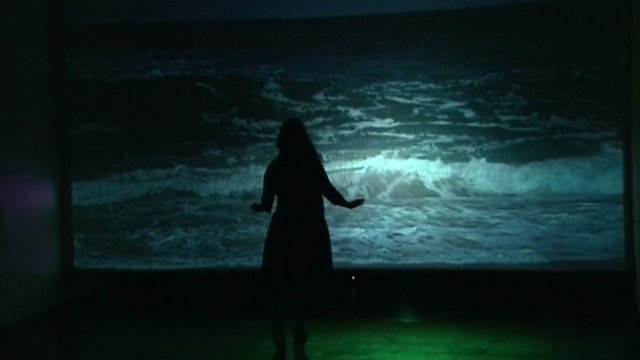
Tragovi koje sjećanje ostavlja za sobom, gubi ih, ponovo nalazi i umnaža, uzbuđenje i bol sjećanja, vremena koje se kreće u svim smjerovima.
Da, avangardni film je najavio način na koji danas funkcionira - novac.
I read the partial translation of Thierry Kuntzel's notebooks (in part) 8 years ago, and in total a few years ago. I find him a fascinating thinker. I've not read his full (theoretical) essays yet because I'm not entirely convinced that they'll satisfy my interests, but I love his notebooks and his way of thinking creatively aligns wonderfully with mine.
Until this, I'd never been able to see any of his films in total. There are clips of most of his oeuvre included on a DVD-ROM that comes with the notebooks, but they make it truly hard to get an impression of the work. The writing about Nostos I is fascinating, the clip I had seen not so much.
However, the video in total is actually truly wonderful. It achieves a true sense of oneircism just by the silent hypnotic ennui it lulls you into as a viewer. The first time the camera shifts away from the image seen in the poster is truly shocking, and from there the film becomes a beautiful rorscharch test of figuration, moving around the frame of video and somehow magically creating an atmosphere of intensity. Not an easy film by any means, and having seen it I can almost understand an influence, perhaps, on Grandrieux's Unrest trilogy (Grandrieux worked with Kuntzel in the early 80s, which is how I first heard of Kuntzel). A wonderful work. - Mike Kitchel
https://letterboxd.com/murdermystery/film/nostos-i/
Pervaded with references to Max Ophuls' classic film Letter From an Unknown Woman, Nostos I uses video to explore obsession, the imaginary and memory, relating the cinematic apparatus and the psychical apparatus. Kuntzel describes this work: "Three people, or rather three silhouettes of rare objects — frames, windows perhaps, a[n] illustrated manuscript — and a few minimal actions: pages being leafed through, someone sitting down, someone lying down, getting up, crossing a space, lighting a cigarette, a head turning, a mouth opening, someone looking around. There is hardly any representation in Nostos I: just enough to tip-toe around the edges of analogy, illusion, under the image and in between images." Unfolding as memory traces and dream images, figures and objects appear and disappear, decompose and recompose; disjointed fragments evolve in continuous transformation and manipulations of light and time. Raymond Bellour refers to the "traces that memory leaves behind, wipes out and recaptures again, the agitation and pain of a memory at work... The spectator, projected outside himself, comes to experience the functioning of his own mind." - https://www.eai.org/titles/nostos-i
French film theorist and videomaker Thierry Kuntzel, whose distinguished writings are among the major contributions to the textual analysis of film, also produced an original body of videotapes and installations. Kuntzel's theoretical texts propose significant applications of psychoanalytical and semiological constructs as elaborations of the relation of the filmic and psychical apparatuses. Among the concepts that he elucidated in the context of the cinema are condensation and displacement, defilement, the imaginary and the unconscious, the "dream-work" and the film-work.
In the late 1970s, Kuntzel shifted from the analysis of film to the production of video. Minimalist in representation yet richly layered in suggestive content, works such as Nostos I (1979), Time Smoking a Picture (1980) and Le peintre cubiste (1981) use video to uncover the essence of the perception of reality and representation, memory and the unconscious, in relation to the codes of cinema, photography and painting. Employing the transformative potential of video technology, these evocative works unfold as elusive, implied fictions, visualizations of shifting passages of time, light and movement.
Raymond Bellour has observed that for Kuntzel, video becomes a medium analogous to Freud's "magic writing pad," a means of transcribing the unconscious processes of the psychical and the real. His tapes are informed by use of the paluche — a miniature, portable camera that functions as an extension of the hand, rather than the eye. Indeed, Bellour has written that it was the "paluche, and its 'writerly,' even calligraphic, qualities that inspired Kuntzel to make the leap from film theory to video art." Grounded in discursive theory, Kuntzels' video works also resonate with a haunting poetry.
Kuntzel was born in 1948 in Bergerac, France, and died in 2007. He studied philosophy, linguistics and semiotics with Roland Barthes and Christian Metz at l'Ecole des Hautes Etudes en Sciences Sociales, where he earned a doctorate. He was head of the Research Division of both the French Radio and Television Office (ORTF) and Institut National de la Communication Audiovisuelle. He produced a number of experimental video works in conjunction with the Departement des Programmes at the Institut National de l'Audiovisuel in Paris. Kuntzel taught semiotics of cinema and textual analysis of film at the University of Paris; the Centre d'Etudes Americain du Cinema, Paris; and the State University of New York, Buffalo, among other institutions. His writings have been widely published, appearing in such journals as Camera Obscura, Revue d'Esthetique, Communications, and Quarterly Review of Film Studies. His video work was the subject of a 1984 retrospective at the Centre Georges Pompidou, Paris, and has been exhibited internationally at festivals and institutions, including the University Art Museum, Berkeley, California; Paris Biennale; American Center, Paris; The Museum of Modern Art, New York; and the Stedelijk Museum, Amsterdam. Kuntzel lived in Paris until his death in 2007.
https://www.eai.org/artists/thierry-kuntzel/biography
about "Venises":
http://www.kibla.org/en/sections/kibela-space-for-art/archive/kibela-arhiv/2008/thierry-kuntzel-venisesgilles-zabava-ob-kibelinem-9-rojstnem-dnevu-eng/
Thierry Kuntzel: Sunrise: A Song of Two Humans
Nema komentara:
Objavi komentar